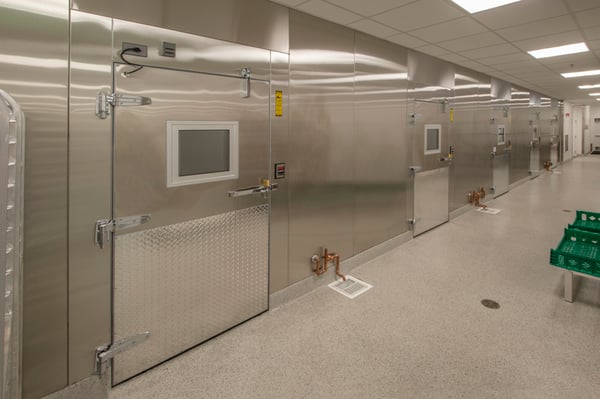 Complex hinge design is a staple of many high-end, high-performing products. The math required to make your lid, cover, or door work as advertised can be wildly different depending on your application.
Complex hinge design is a staple of many high-end, high-performing products. The math required to make your lid, cover, or door work as advertised can be wildly different depending on your application.
More specifically, hinge torque is largely contingent on its end-use. Finding that perfect balance in a hinge mechanism design is the backbone of the overall function of your product.
If you get your hinge design calculations wrong? It can be a disaster for your product’s longevity, safety, and PR.
To further enforce proper hinge design -- for both vertical and horizontal pivots -- here are the calculations you need and a scary look at the consequences of failure:
What's the Importance of Torque in Hinge Design Calculations?
You calculate door or lid torque to inform what your hinge will do at set points in its range of motion. If it’s a heavy lid, such as one on a cryogenic freezer or an industrial toolbox, even a small change in the center of gravity is important.
You can learn three ways to calculate the center of gravity here.
Lid torque is all about striking that perfect balance. For a vertical axis, door torque calculations influence performance and the ability to maintain a good seal on the door.
A refrigerator hinge is the textbook example of this concept. When your customer closes his refrigerator door, you want it to engage the seal and stay shut. You want the door hinge to self-close so that if the door rebounds from being slammed too hard, it shuts anyway.
For a horizontal axis, torque’s most important function is helping you make a safe, easy-to-lift lid. The seal can be important here too, such as with a chest freezer, but gravity helps you out here.
It's also worth mentioning constant torque hinges. Doors with these mechanisms can be moved to a certain point along the range of motion, then stay in place. A good example is an adjustable computer monitor that allows the user to customize the viewing angle.
How to Calculate Torque in a Hinge Design
Torque is force x distance.
Force is any interaction that will cause an object to move -- this includes gravity. In this formula, distance is measured from the center of gravity to where the hinge pivot is going to be located. If you install a mechanical hinge that’s close to the lid on the back and you add a counterbalance system, that pivot may change, and the level of torque must change with it.
The easiest way to calculate torque is to completely take any guesswork out of it. The Vectis DYO app allows you to find the right torque by simply plugging in four parameters of your design:
- Lid weight
- Lid center of gravity to the hinge pivot axis
- Horizontal distance
- Vertical distance
What Happens if the Number Is Off?
It’s best to not find out yourself, so here’s a fair warning on what can happen if your hinge torque is off. The answers are very different depending on whether your application uses a vertical or horizontal pivot.
In a vertical axis pivot, such as with the fridge hinge example, miscalculated torque can lead to a door slamming too hard. This wears on the components and makes them prone to early failure. Even if the door stays on through its intended lifetime, it may not fully seal. Last we checked, a fridge is no good if the food inside it can’t stay fresh.
Too much force can actually be a deadly possibility in a refrigerator door hinge. You’re limited -- under the mandate of Underwriters Laboratory -- to limit opening force to 15 lbs. in a refrigerator. This is to keep children from being trapped in the appliance.
On a horizontal lid, excessive torque will keep the lid from opening properly. If your self-closing angle is too high, you’ll also have an unsafe product, especially if it's a heavy lid like you’d see in a chest freezer or industrial toolbox. If the lid or cover gains too much momentum, it will slam, potentially hurting the user and definitely causing wear and tear on the product.
Other Hinge Design Considerations
In addition to calculating torque, there are a variety of other factors that fit into the big picture of motion control design. Other variables you'll need to know to include the balance angle, balance point, and lid weight.
There are other surprising factors that go beyond the hinge itself:
 The Supporting Cast
The Supporting Cast
When you mount the hinge, you have to have enough supporting structure to handle torque.
The key term here is deflection. This act of physics is something you see at the fishing docks. When you throw out your line, the rod is straight. But when a fish hooks on and starts fighting, the pole bends.
That bending is deflection. The force is still being transmitted, but it didn’t pull the rod out of your hands. In the case of a horizontal pivot like a ceramic smoker lid, if the structure is being bent out of where the hinge mounts, the surrounding material is deformed and the lid isn’t getting proper support.
This excess torque means you may need to use reinforcements on that portion of the product:
- Thicker materials
- Heavier materials
- Added bracings
With a vertical axis, you're more worried about vertical loading going back to, say, a cabinet. Make sure you have proper mounting and fastening to account for this pressure. If your attachment method is loose or you're using overly thin materials, the movement won't give you the proper door closure.
Screwing Up
To fasten or not to fasten is not the only question -- the way you install your lid or door also can hamper its motion control features.
When you screw in a hinged component, you're putting a lot of force into those fasteners. If you over-torque with the screw gun, the screws can fail prematurely.
To avoid making a mistake this late in the game, remember to use torque calculations in the install as well. Faulty fastening has led to everything from cabinet doors hanging loose to fridge doors completely falling off -- a huge liability issue.
DIY With DYO
Again, the easiest way to calculate a torque curve is to work with the Vectis DYO app. By combining the app with an expert hinge manufacturer, you can match up torque at various angles throughout the range of motion to give a true counterbalanced feel to your lid.
There’s a lot of advanced math involved in these hinge design guidelines. To get a better sense of where your design lacks safety, functionality, or durability, ask an engineer below -- you can also get a walkthrough of the DYO app process!
(Editors Note: This article was originally published in April 2020 and was updated in December 2021 to reflect current and updated information)
.png?width=12000&height=2033&name=WeberKnappLogo_white%20(1).png)



